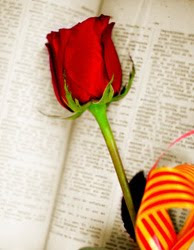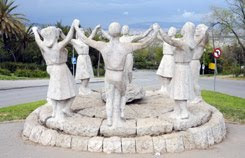It’s coming up to one of the most the most magical days in Barcelona. Locally, it’s simply known as ‘La Diada de Saint Jordi’, internationally as ‘International Book Day’ and casually as the ‘Catalan St. Valentine’s’. The truth is that all are pretty much correct. But first a bit of background.
Saint Jordi (or George) is the patron Saint of Catalunya and his designated Saint’s day is April 23rd. By a happy coincidence, this is also the day Shakespeare and Miguel Cervantes (writer of the classic Sp anish epic Don Quixote) died.
anish epic Don Quixote) died.
A red rose, the symbol of the dragon-slayer’s bravery, has traditionally been given to girlfriends, mothers and female lovers on this day. But back in the 1920s, a local bookseller decided to get a bit of leverage out of the literary connection to the date, and soon women retaliated their gift of a rose with one of a book to their boyfriends/fathers/lovers.
Given all this activity, UNESCO then stepped in and declared April 23rd the ‘International Day of the Book’ though its certainly not celebrated with as much zeal anywhere as it is in Barcelona.
From early morning onwards, rose sellers set up stalls along the streets, washing them in vivid red colour, and the distinctive red and gold striped Catalan flag waves everywhere.
Booksellers also set up stalls, particularly along the Las Ramblas and the Passeig de Gràcia. Most of all, and particularly in the early evening, people just come out to enjoy their city, lovers to give each other their special gifts and whole families revelling in the warm, dappled light of Barcelona in the springtime.
Saint Jordi (or George) is the patron Saint of Catalunya and his designated Saint’s day is April 23rd. By a happy coincidence, this is also the day Shakespeare and Miguel Cervantes (writer of the classic Sp
 anish epic Don Quixote) died.
anish epic Don Quixote) died.A red rose, the symbol of the dragon-slayer’s bravery, has traditionally been given to girlfriends, mothers and female lovers on this day. But back in the 1920s, a local bookseller decided to get a bit of leverage out of the literary connection to the date, and soon women retaliated their gift of a rose with one of a book to their boyfriends/fathers/lovers.
Given all this activity, UNESCO then stepped in and declared April 23rd the ‘International Day of the Book’ though its certainly not celebrated with as much zeal anywhere as it is in Barcelona.
From early morning onwards, rose sellers set up stalls along the streets, washing them in vivid red colour, and the distinctive red and gold striped Catalan flag waves everywhere.
Booksellers also set up stalls, particularly along the Las Ramblas and the Passeig de Gràcia. Most of all, and particularly in the early evening, people just come out to enjoy their city, lovers to give each other their special gifts and whole families revelling in the warm, dappled light of Barcelona in the springtime.
